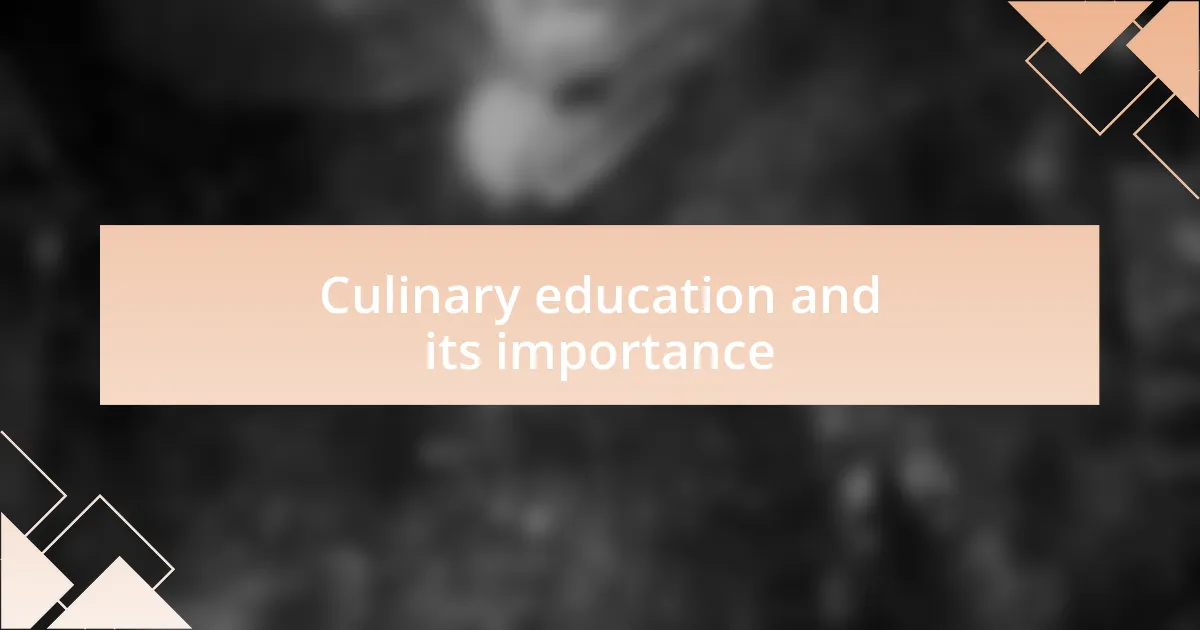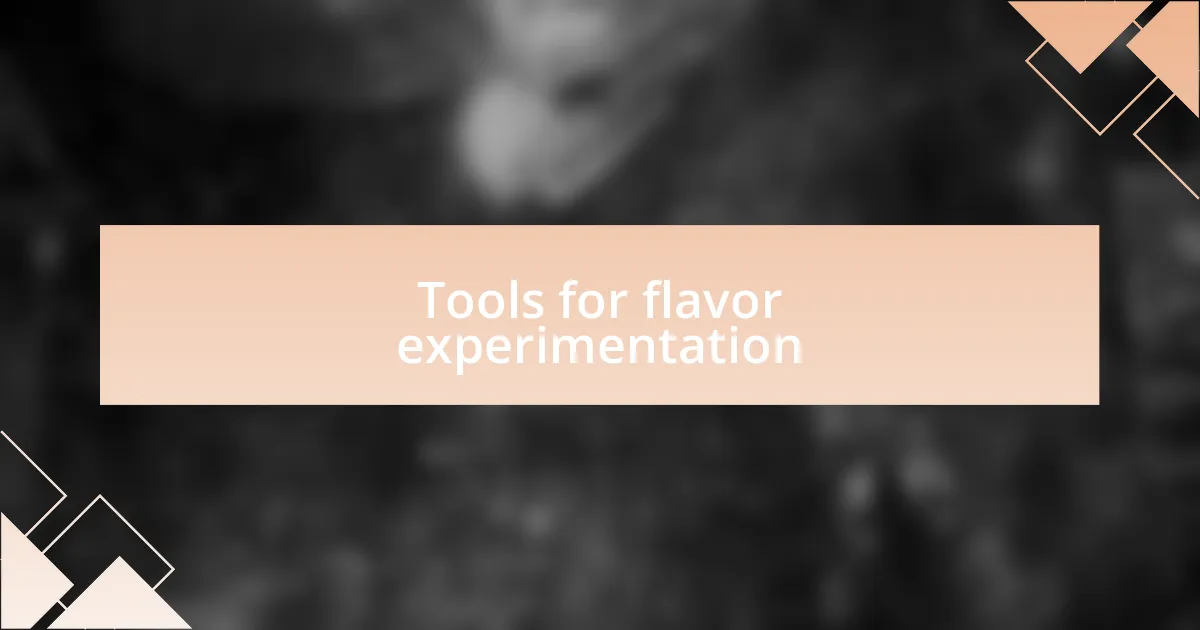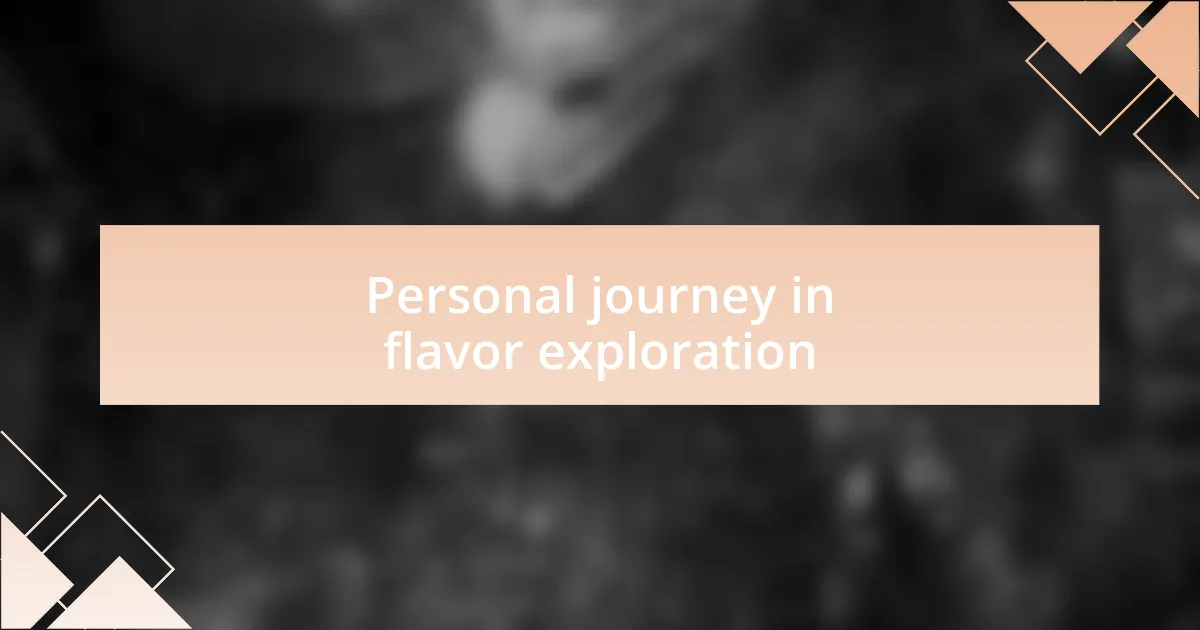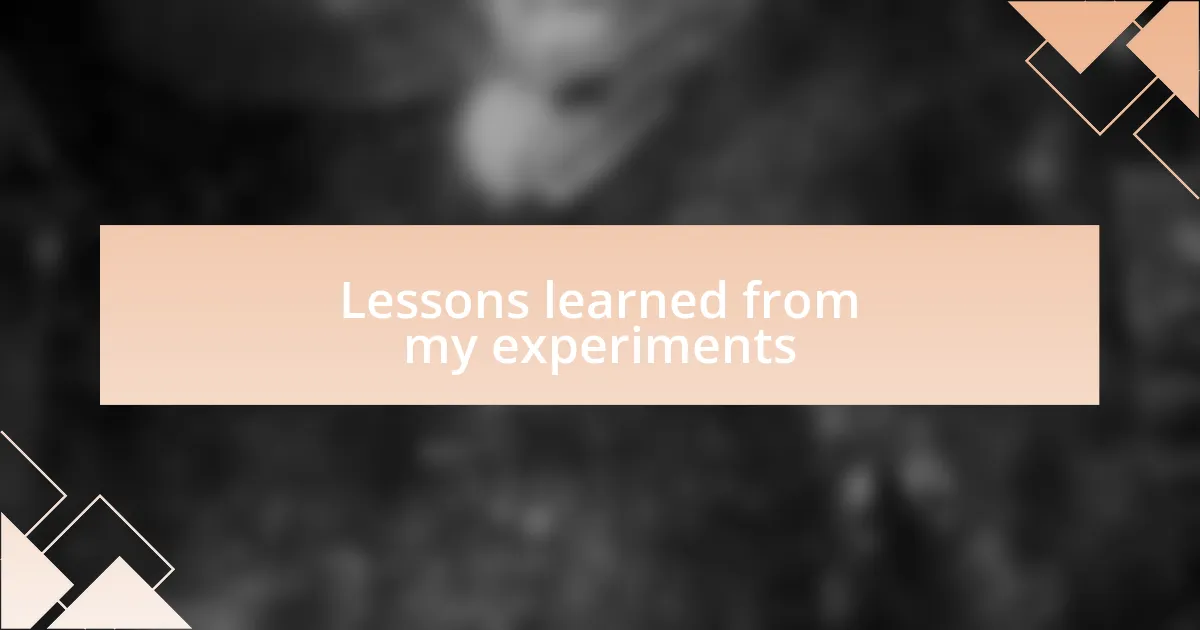Key takeaways:
- Culinary education enhances understanding of flavors, techniques, and fosters a supportive community among food enthusiasts.
- Experimentation with flavor combinations, such as contrasting elements and layering, is crucial for culinary creativity.
- Maintaining a notebook and using precise measurements can significantly enhance flavor exploration and culinary success.
- Personal flavor explorations reveal the importance of spontaneity and the joy of discovering unexpected pairings.

Culinary education and its importance
Culinary education serves as a vital foundation for anyone passionate about cooking. I vividly remember my first day at culinary school—the excitement, the scents of fresh herbs, and the feeling of stepping into a world brimming with possibilities. Isn’t it fascinating how much a structured program can shape our understanding of flavors, techniques, and presentation?
When you dive into culinary education, you’re not just learning how to chop or sauté; you’re exploring the science behind flavors and the art of creating memorable dishes. I still think back to a day in the classroom when we experimented with umami, a taste I previously overlooked. The moment I learned how to balance savory and sweet in a dish, it was like opening a door to creativity I never knew existed.
Moreover, culinary education offers a sense of community that is incredibly enriching. I found friendships with fellow food enthusiasts who share the same passion for innovation and taste. Don’t you think that connecting with others who have the same love for food can inspire new ideas and encourage collaborative experiments in the kitchen? This support system can be the fuel for experimentation and growth in one’s culinary journey.

Fundamentals of flavor combinations
Flavors interact in fascinating ways, and understanding this interplay is key to successful cooking. I recall a day when I was playing with the combination of citrus and herbs. The bright acidity of lemon paired with fresh basil transformed a simple vinaigrette into something extraordinary. Can you see how that zing can elevate a dish? It’s moments like these that reveal the importance of experimenting with contrasting flavors.
When I first learned about complementary flavors, it truly changed my approach to cooking. For instance, the balance of sweet and spicy in a dish made with honey and chili pepper created a memorable experience. Have you ever noticed how those contrasting elements can leave a lasting impression? This synergy is the foundation upon which countless culinary masterpieces are built.
Lastly, I’ve discovered that certain flavors evoke specific emotions and memories. For me, the scent of freshly baked bread and the bitterness of dark chocolate bring a wave of nostalgia. The emotional connection to food can enhance a dish and create a deeper experience for anyone tasting it. Have you ever paused to think about how certain flavors make you feel? Understanding these nuances is a powerful aspect of flavor combinations and can truly elevate your culinary creations.

Techniques for experimenting with flavors
One of my favorite techniques for experimenting with flavors is to create a flavor wheel. I often jot down different taste categories—like sweet, salty, bitter, and umami—and then branch out into specific ingredients within those categories. For example, pairing the umami of soy sauce with the sweetness of maple syrup opened up a new world for my stir-fries. Have you tried mapping out your own culinary adventures?
Another approach I enjoy is utilizing the method of layering flavors. It’s all about starting with a base and gradually adding accents. I remember making a simple tomato sauce and adding a touch of smoked paprika, which completely transformed the dish. By layering these flavors thoughtfully, I find that each ingredient stands out while still working together harmoniously. Have you considered how the order of adding ingredients can change the outcome of your dish?
Moreover, I often play with temperature contrasts when blending flavors. This might sound simple, but I’ve found that pairing a chilled fruit salsa with warm grilled fish can create a delightful experience for the palate. The combination not only tantalizes the taste buds but also offers a delightful contrast in texture. This idea of juxtaposition leads me to wonder—what other unexpected pairs have you encountered in your cooking journey?

Tools for flavor experimentation
When it comes to tools for flavor experimentation, one of my most trusted companions is a good notebook. I love documenting my culinary experiments, connecting ideas, and recording my thoughts after each dish. There’s something almost meditative about jotting down what works and what doesn’t; it really heightens my awareness of flavor dynamics. Have you ever stopped to write down your culinary successes and failures?
Another invaluable tool in my kitchen is a digital scale. I’ve learned that precise measurements can lead to remarkable discoveries. For example, the first time I weighed out equal parts of garlic and ginger for a sauce, I discovered a balance that brought depth to my dish. It’s fascinating how sometimes, just a few grams more or less can shift the entire flavor profile. Have you ever realized how measurements impact your culinary creations?
Lastly, I can’t overlook the importance of high-quality flavoring agents—like spices and extracts—in my experiments. When I decided to enhance a chocolate truffle recipe with a hint of lavender, I chose organic lavender buds to ensure a clean taste. The subtle floral notes elevated the experience entirely. What unique flavor accents have you tried adding to your favorite desserts?

Personal journey in flavor exploration
My journey in flavor exploration began with simple curiosity and a dash of courage. I vividly remember the first time I paired balsamic vinegar with strawberries—an impulsive choice based on a fleeting suggestion from a cooking show. The moment those tangy and sweet notes danced on my palate, I was hooked. Have you ever stumbled upon a flavor pairing that completely surprised you in a delightful way?
As my confidence grew, I started experimenting with more unexpected combinations, like smoked paprika and chocolate. One evening, while trying to impress friends at dinner, I added a pinch of smoked paprika to a chocolate mousse. The smoky warmth juxtaposed with the rich sweetness was an experience that left everyone raving. It made me think—how often do we confine ourselves to traditional pairings, missing out on spectacular surprises?
Now, I approach flavor exploration as an adventure. Recently, I decided to mix herbs like cilantro into fruit salsas, embracing a savory twist. Each time I taste something unusual, I feel a surge of excitement. It’s like uncovering a secret in the culinary world. Have you ever felt that thrill when an experiment leads to an entirely new discovery in flavor?

Lessons learned from my experiments
Throughout my experimentation, I found that not every combination works as well as I hope. For instance, one evening, I tried mixing blue cheese with honey in a savory spread. While the sweetness of the honey was supposed to complement the cheese’s sharpness, the result was more jarring than harmonious. It taught me that sometimes, contrasting flavors can clash rather than create a seamless union. Have you ever had a flavor experiment that left you scratching your head?
The joy of flavor experimentation often comes from the unexpected successes. I vividly recall a time when I combined roasted peaches with a hint of cardamom for a summer dessert. The warmth of the cardamom enhanced the peaches’ sweetness in a way that felt completely new. This experience reinforced my belief that the thrill of culinary discovery lies in those delightful surprises. Who doesn’t love the moment when an unassuming ingredient transforms a dish into something sublime?
One significant lesson I’ve learned is to trust my instincts and embrace spontaneity. I remember mixing fresh basil with ripe watermelon at a picnic, unsure of how it would taste. The result was a refreshing burst of flavors that brightened the day. It made me realize that sometimes, the best combinations come from a place of curiosity, not strict rules. Have you ever felt inspired to combine ingredients simply because you wanted to see what might happen?

Tips for successful flavor pairing
When it comes to successful flavor pairing, balancing flavors is key. I remember trying to bring together coconut and lime in a drink. At first, I added too much lime, and the drink became overly tart. It wasn’t until I dialed back the acidity that the creamy coconut could truly shine. Have you ever noticed how a small adjustment can make such a big difference?
Another tip is to consider texture along with flavor. I once paired crispy roasted Brussels sprouts with a velvety, garlic-infused yogurt. The contrast in textures created a delightful experience on the palate. It made me think about how flavor isn’t just about taste, but also about how a dish feels. What textures do you enjoy playing with in your own cooking?
Lastly, don’t shy away from inspiration outside of your usual cuisine. I found success when I blended traditional Italian herbs with spicy Thai chilies in a pasta dish. Initially, I was skeptical—even worried about how those bold flavors would mingle. But the result was a surprisingly harmonious dish that told a story of culinary fusion. Have you ever ventured into uncharted territory with your flavor combinations? The rewards can be spectacular.